The Importance of 14 Carat Gold Rings
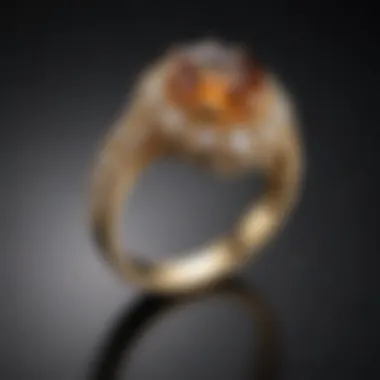
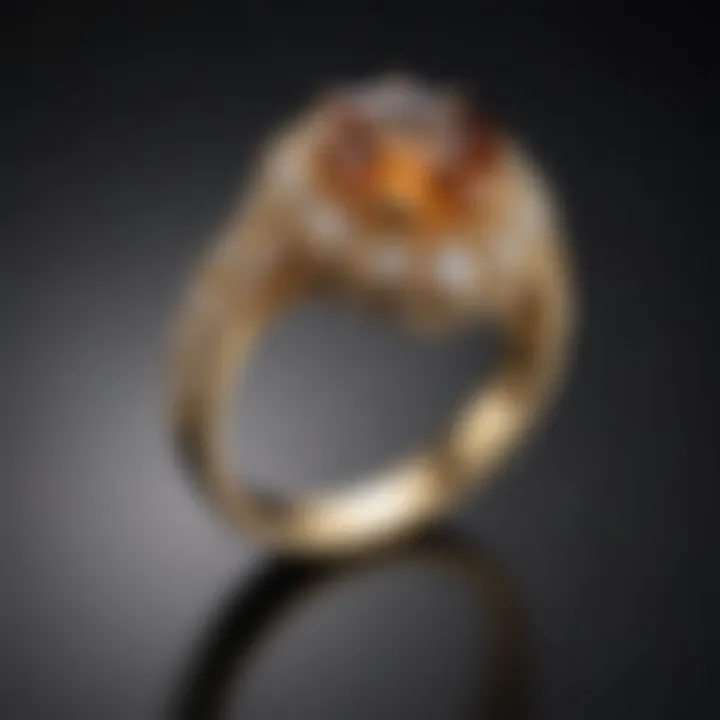
Intro
In the world of luxury and adornment, few items carry the same weight or significance as a gold ring. When it comes to gold, the 14 carat option stands out, not just for its captivating sheen but also for its profound meaning across history and cultures. This article guides the reader through the essence of a 14 carat gold ring, shedding light on its properties, significance in the realm of jewelry, and insights into what makes it a timeless choice.
Gemstone Overview
Definition of Gemstones
While the focus here is predominantly on gold, it's crucial to understand the wider context of gemstones in jewelry. Gemstones can be defined as natural minerals or organic materials that have been cut and polished to enhance their beauty. 14 carat gold, while not a gemstone in the traditional sense, plays a vital role when combined with precious stones like diamonds or sapphires, creating exquisite pieces that elevate the overall aesthetic.
Classification of Gemstones
Gemstones fall into two primary categories: precious and semi-precious. Precious stones include diamonds, rubies, sapphires, and emeralds. Semi-precious stones encompass a wider variety, for instance, amethyst, garnet, and turquoise.
Gold, particularly in its 14 carat form, could be seen as a ‘metallurgical gemstone’; valued for its rarity and beauty. Here, it forms the base, complementing or emphasizing the allure of the gems that might be displayed alongside it.
Historical Significance
Origins of Gemstone Use
The use of gemstones in adornment can be traced back to ancient civilizations, where people donned them not just for beauty but also for perceived mystical qualities. Gold, especially, has been a symbol of wealth and power throughout history. 14 carat gold rings found their place in cultures from Egypt to Rome, reflecting an evolution in the alloying processes that made gold more versatile and accessible.
Cultural Insights: Gemstones in Ancient Civilizations
Different cultures have attached profound meanings to gemstones and gold. For example, in ancient Egypt, gold was associated with the sun, representing eternity and divine power. The 14 carat gold ring, made with an alloy comprising 58.3% pure gold, might not hold the same historical prestige as higher carat options, but it is prized for its balance of durability and appearance.
"Gold is the most malleable and ductile of metals—drawn out, it can be fashioned into a thin thread or an intricate setting that enhances the beauty of gemstones."
The lore surrounding gold and gemstones reflects not only aesthetic values but also deep-rooted symbolism—representations of love, status, and even spiritual beliefs.
Understanding these aspects enriches the appreciation of a 14 carat gold ring, transforming it from a mere object of beauty into a vessel of history, culture, and personal significance. Each piece tells a story, echoing choices made by artisans and wearers throughout time.
With this groundwork established, we move forward to explore the aesthetic appeal of 14 carat gold rings and their modern relevance in today’s society.
Understanding Gold Purity
Gold purity plays a crucial role in determining the value and quality of gold jewelry, including 14 carat gold rings. The karat measurement indicates the proportion of pure gold in an alloy, which ultimately affects its appearance, durability, and price. For those interested in investing in gold jewelry, especially a 14 carat gold ring, understanding the nuances of gold purity is essential.
In simple terms, a higher karat signifies a greater percentage of gold. For instance, 14 carat gold contains 58.3% gold, while other karats like 10, 18, or 22 have differing gold contents. This percentage directly impacts the ring's color, luster, and resistance to wear and tear. Gold can be alloyed with other metals to enhance specific desired attributes, including strength and color. Therefore, knowing how purity relates to these aspects informs better purchasing decisions and helps avoid potential pitfalls when selecting jewelry.
The Basics of Gold Karat
Karat (spelled "carat" when referring to gemstones) is a unit measuring the purity of gold. Jewelry enthusiasts find it particularly important because it gives insight into the composition of the gold. The scale runs from 1 to 24 karats, with 24 karat being pure gold. However, pure gold is exceptionally soft and not commonly used for jewelry. Thus, different karats balance the purity and practical needs of jewelry wearers.
Most jewelry is made with lower karat gold since a mixture of metals creates more durable pieces. When investing in a 14 carat gold ring, one is getting a balance of desirable gold content and sufficient resilience for everyday wear.
The Composition of Carat Gold
14 carat gold is composed of 58.3% gold, which is a considerable amount compared to other alloys. The remaining 41.7% consists of metals like copper, silver, and occasionally nickel or palladium, which contribute specific qualities to the gold alloy.
- Copper enhances strength and imparts a warm tone, commonly seen in rose gold variations.
- Silver can lighten the hue, often providing a more yellow appearance, especially in traditional yellow gold settings.
- Nickel or Palladium can offer a more modern touch, especially for white gold rings, giving them a bright, silver-like shine.
This careful combination of metals not only keeps the material strong but also expands the color options available. When selecting a 14 carat gold ring, understanding the composition can clarify why two rings may look or feel different even if they both bear the same karat marking.
Comparing Gold Alloys
Knowing how 14 carat gold stands against other gold varieties is important for making an informed decision. Here's a closer look:
Carat Gold
10 carat gold is the minimum karat to be considered genuine gold, containing 41.7% gold. While it's cheaper, it has a relatively lower value and is less desirable for fine jewelry. Its main advantage lies in its durability due to a higher percentage of alloy metals, which might make it suitable for more casual jewelry pieces that experience more wear and tear. However, purists often regard its lower gold content as a drawback.
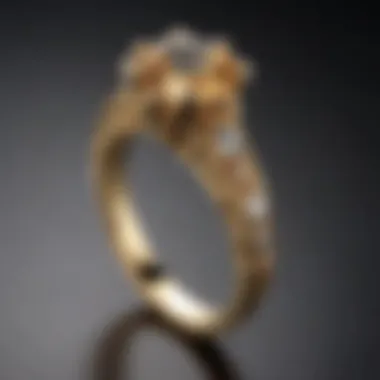
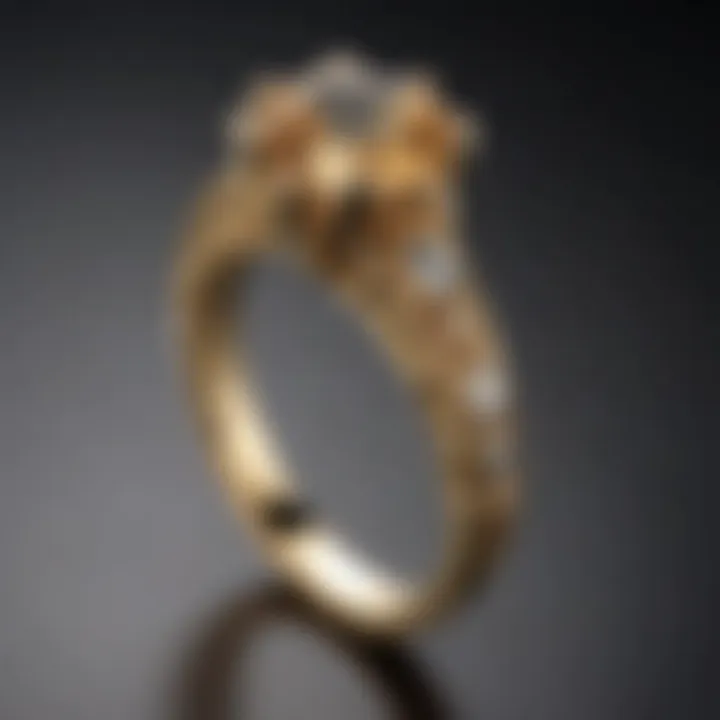
Carat Gold
On the other end of the spectrum, 18 carat gold contains 75% gold. It offers a richer hue and higher value than 14 carat gold, which attracts enthusiasts. The downside is that it can be softer, making it more prone to scratches or dents. For those looking for a balance of beauty and resilience, 18 carat is an excellent choice.
Carat Gold
22 carat gold, with 91.7% gold content, is renowned for its beautiful, warm yellow color. It’s a top pick in cultures where gold symbolizes wealth and prestige. However, it’s often too soft for everyday wear, making it susceptible to scratches and deformities. Therefore, while appealing, its practical use is limited, and it may not be the best choice for a ring intended for daily use.
"The choice of gold karat is more than just a number; it reflects personal style, practical need, and an appreciation for the material's intrinsic value."
The comparative insights here highlight how the karat influences both aesthetic value and practicality. Making an informed decision requires understanding these distinctions, particularly when it comes to a cherished piece like a 14 carat gold ring. Ultimately, knowing the characteristics of different gold alloys assists buyers in choosing pieces that harmonize with their lifestyle and preferences.
Historical Perspective
The historical perspective of 14 carat gold rings plays a vital role in understanding the allure and reputation of this precious metal throughout the ages. When we examine the evolution of gold jewelry, the significance of cultural interpretations, and the history of gold mining, we come to appreciate not just the material itself, but what it symbolizes in human society. Each of these elements contributes layers of meaning to the 14 carat gold ring, enriching its value for collectors, designers, and enthusiasts alike.
Evolution of Gold Jewelry
The journey of gold jewelry from ancient artifacts to modern fashion statements is a fascinating reflection of changing societies. Gold has been valued since time immemorial, often serving as a currency and a mark of prestige. In the early days, goldsmiths created ornaments that were not just decorative; they were symbols of power and authority. For instance, in ancient Egypt, gold funeral masks adorned the deceased, showcasing their wealth and status in the afterlife.
As centuries progressed, the use of gold jewelry became more widespread among various cultures. The Romans introduced intricate designs, often combining gems with gold, adding to their visual appeal. This practice set the groundwork for craftsmanship seen in today’s 14 carat gold rings. In more recent history, the industrial revolution allowed for mass production, making gold jewelry accessible to a broader audience without losing its enchanting essence.
Cultural Significance Through Ages
Culturally, gold represents more than just wealth. Its warm glow and rarity have made it a symbol of love, loyalty, and commitment in many societies. Traditions such as the exchange of gold rings during marriage ceremonies emphasize its emotional significance. For instance, in Western cultures, the gold ring signifies eternal love, while in Indian culture, it is often a part of elaborate wedding ceremonies, showcasing familial bonds.
Different cultures have also embraced distinct styles and meanings. In China, gold is seen as a harbinger of good luck and prosperity, often worn during celebrations and festivities. Similarly, African cultures use gold jewelry as a representation of identity, heritage, and social status.
The enduring significance of 14 carat gold rings is steeped in these cultural narratives, making them not just adornments but carriers of rich histories.
The Journey of Gold Mining
The story of gold mining is as ancient as the gold itself. Initially, gold was extracted from riverbeds and surface deposits using simple tools and techniques. As demand increased, mining methods evolved. Today, the process is sophisticated, yet it carries echoes of its past, emphasizing the vast human efforts that have gone into obtaining this coveted resource.
In the 18th century, gold rushes transformed economies and societies. Whether it was in California or South Africa, these events drew countless individuals, often reshaping towns and communities in the process. Modern-day mining operations have since adopted more advanced techniques, but the environmental impact and ethical considerations surrounding gold mining continue to be a hot topic, igniting debates about sustainable practices.
The evolution of mining encapsulates the struggle and joy of acquiring this gleaming metal; it’s a journey that links our present to the rich histories of civilizations.
"Gold is not just a metal. It’s a connection to our past and a testament to human ingenuity and resilience."
Aesthetic Attributes of Carat Gold Rings
The allure of 14 carat gold rings lies in their unique aesthetic appeal. This section sheds light on why the characteristics of these rings matter not just in aesthetics but also in expressing personal identity and value. The combination of color, design, and craftsmanship makes these rings a preferred choice for many jewelry aficionados. Understanding these aesthetic attributes can help buyers make informed choices that cater to both taste and occasion.
Color and Luster
Yellow Gold
When one thinks of gold jewelry, yellow gold usually springs to mind. Its rich, warm hue is undeniably appealing and exudes a sense of timeless elegance. The 14 carat composition gives it a balance between durability and a strong gold presence. This color doesn’t just stand out; it offers a classic charm that suits various skin tones, making it a popular selection in this article. A unique feature is its ability to smoothly blend with both casual and formal attire, allowing its wearer to showcase a bit of glimmer no matter the occasion.
Advantages: The vivid color of yellow gold has a certain nostalgia tied to it, evoking memories of traditional ceremonies and heirloom pieces. Moreover, it requires minimal maintenance compared to other potential alloys since it's less prone to tarnishing.
Disadvantages: One must consider that yellow gold, being softer than some other metals, can be susceptible to scratches. However, proper care can mitigate this concern.
White Gold
White gold offers a modern twist. Often plated with rhodium, this metal gives a bright, steely sheen that many find irresistible. The cool tones of white gold provide a contemporary aesthetic that complements various gemstones beautifully. This metal's clean and sophisticated allure lends itself very well to engagement rings and other significant pieces, highlighting its value in the overall aesthetic of 14 carat gold rings.
Advantages: Its neutral tone makes it a versatile option suitable for almost anyone. Additionally, white gold is often seen as a symbol of elegance and luxury, making it an attractive choice for special occasions.
Disadvantages: On the flip side, the rhodium plating can wear over time, leading to potential re-plating. Thus, some maintenance is advisable to ensure it retains its shine.
Rose Gold
Last but certainly not least, rose gold has gained quite the following in recent years. This alluring blend of gold and copper creates a warm blush tone that has become extremely trendy. Rose gold rings stand out for their distinctive hue, making them unique within the realm of gold jewelry. They evoke softness and romance, which has contributed to their popularity in contemporary engagement rings. Its unique pastel-like quality sets it apart, creating a sense of intimacy and connection.
Advantages: The romantic touch of rose gold can often complement a variety of gemstones and personal styles. It tends to physically withstand wear better than some other combinations due to its copper content, further enhancing its appeal.
Disadvantages: However, not everyone may prefer its pinkish sheen, and some might find it less suitable for traditional looks. Further, individuals with sensitive skin may experience reactions to copper, although this is uncommon.
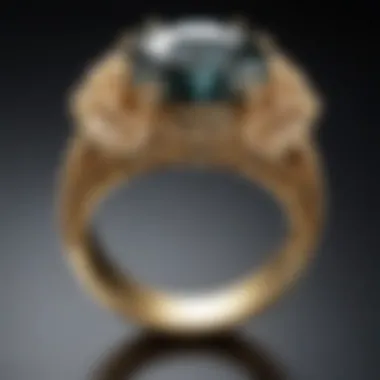
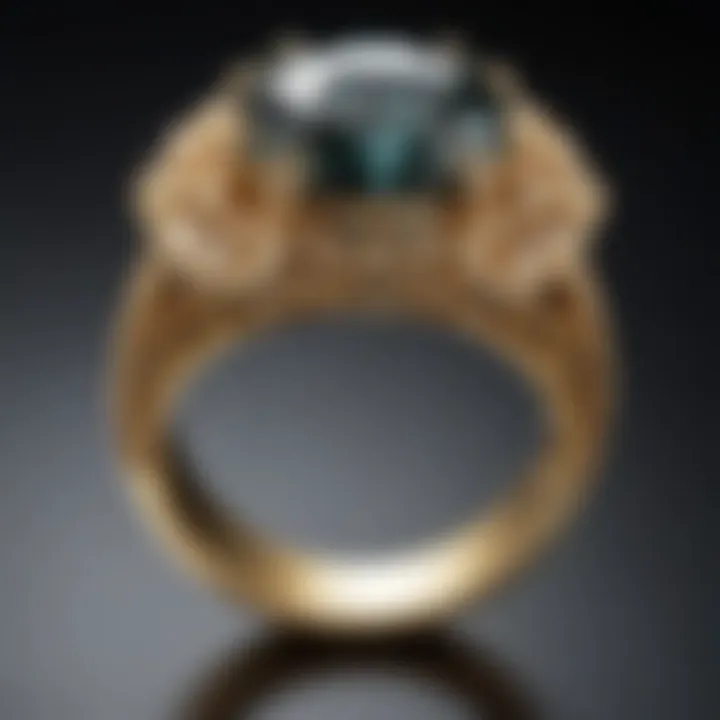
Design Trends
Classic Designs
Classic designs in 14 carat gold rings often pay homage to longstanding traditions. These designs typically emphasize symmetry and timelessness, ensuring that their appeal never fades. They can include elements like solitaires, elegance in simplicity, or intricate engravings, making them a go-to choice for those valuing authenticity and heritage. The enduring style represents not just a fashion statement but a nod to craftsmanship that has endured the test of time.
Advantages: Classic designs are perpetually in vogue, giving them an inherent investment value over fleeting trends. Additionally, their universal appeal ensures they can be worn on various occasions.
Disadvantages: The downside is that they might risk being seen as boring or uninteresting to those desiring more avant-garde styles.
Modern Interpretations
Modern interpretations take the essence of traditional designs and give them a fresh twist. This could involve combining unconventional shapes, asymmetric designs, or incorporating mixed materials. The aim here is to make a bold statement while still maintaining the fundamental luxury of gold and allowing self-expression. In this context, these rings perfectly fit the aesthetic attributes of 14 carat gold rings discussed earlier.
Advantages: They open up avenues for personalization, allowing wearers to showcase their individuality. This trend is particularly appealing for younger generations looking for something unique.
Disadvantages: However, they may not resonate with everyone. Their often experimental nature means they can appear less classic, potentially limiting their long-term appeal.
Customized Pieces
The world of customized pieces in 14 carat gold rings positions wearers at the center of their own creations. Whether it’s engraving a meaningful date, incorporating a family heirloom, or designing an entirely original piece from scratch, customization has become an essential trend. At its core, customization connects personal stories to exquisite jewelry, making each piece a treasure in its own right.
Advantages: Customized rings bear an emotional weight that mass-produced pieces often lack, making them perfect for celebrations like weddings or anniversaries. Buyers can express their sentiment, showcasing elements that are personally significant.
Disadvantages: On the other hand, creating a custom piece may require additional time and financial outlay, as the design process can often be more involved than simply buying off the shelf.
The Emotional Value
The emotional value of a 14 carat gold ring runs deeper than mere aesthetics or craftsmanship. It encapsulates sentiments, connections, and legacies. When a person chooses such a piece of jewelry, it often signifies a pivotal moment in life—be it an engagement, wedding, anniversary, or a personal milestone. The simple act of wearing the ring can evoke a symphony of feelings tied to cherished memories and future aspirations.
Moreover, gold has always held a special place in human relationships. It is seen as a representation of purity, love, and prosperity—a metaphorical blanket of warmth and comfort. A ring crafted from 14 carat gold can serve as a tangible reminder of the promises made and the love shared, resonating with the wearer's life story. This ring is not just an accessory; it is a symbol of commitment and devotion.
"Jewelry takes people’s minds off your wrinkles." – Sonia Henie
Symbolism of Rings
Rings have held symbolic meanings throughout history, and a 14 carat gold ring is no exception. Traditionally, rings signify eternity without beginning or end. The circular shape serves as a constant reminder that love is an unbroken bond, a never-ending cycle of giving and receiving.
In various cultures, gold itself symbolizes both wealth and success. Therefore, a 14 carat gold ring may also reflect the wearer's status or accomplishments. It’s not uncommon for families to pass down rings from generation to generation, embedding personal legends into these embellishments.
Consider the engagement ring, often made from this fine purity of gold. It symbolizes a promise of eternal love and commitment, holding the duo's shared dreams and hopes for the future wrapped in its gleaming hue. The act of presenting a ring during proposals carries with it an emotional heft that goes beyond just a precious metal; it's a heartfelt gesture that seals a new chapter in life.
Rings as Heirlooms
The value of a 14 carat gold ring goes far beyond the market price; it often becomes an heirloom, a statement of familial bonds. When passed down through generations, it transforms into a storytelling artifact, each scratch and imperfection narrating the experiences of those who wore it before.
These rings don’t merely sit in a jewelry box; they hold a unique significance. A grandmother's wedding band, for example, can tell tales of a couple dancing under the stars after their marriage, whispering secrets in the quiet of night, and weathering life's storms together. A mother may pass her ring onto her daughter, entrusting the family legacy, along with the love that it represents.
This sense of continuity strengthens familial connections, reminding each wearer of the love and tradition embedded in each piece. A 14 carat gold ring as an heirloom carries emotional weight that extends across timelines, creating a sense of belonging and shared identity.
Understanding these layers of emotional significance allows for a deeper appreciation of such a piece. When choosing to invest in a 14 carat gold ring, one is not just purchasing a slice of luxury but entering a continuum of love, stories, and traditions that enrich the very fabric of life.
Considerations for Purchase
When delving into the realm of 14 carat gold rings, the significance of choosing the right piece cannot be overstated. These rings are not just mere accessories; they embody emotions, symbolize commitments, and often become cherished heirlooms. Therefore, understanding the aspects of purchasing a 14 carat gold ring—its quality, fit, and budget—can elevate the experience from mere acquisition to a meaningful investment.
Assessing Quality and Authenticity
Before parting with your hard-earned money, determining the quality and authenticity of a 14 carat gold ring is crucial. Gold purity is often marked on the jewelry itself. Look for stamps such as "14K" or "585," which indicate that the piece consists of 58.3% pure gold. Also, the overall craftsmanship may showcase its worth. For example, meticulously setting gemstones or well-finished edges can hint at a high-quality piece. A trusted jeweler will provide certification or documents confirming authenticity, which serves as a safety net for buyers. Simply put, the investment into an authentic piece ensures that you don’t end up with a faux or subpar product.
A few practical steps to ensure quality include:
- Check for Hallmarks: Inspect for purity marks clearly etched onto the band.
- Seek Certifications: Always request a certification of authenticity from the seller.
- Trustworthy Jewellers: Buy from reputable sources, as word-of-mouth recommendations can also be beneficial.
"Quality is remembered long after the price is forgotten."
Choosing the Right Fit
The fit of a ring holds tremendous importance, as an uncomfortable ring can lead to annoyance in daily wear. Before making a purchase, understanding your ring size is key. This often involves measuring the finger accurately, though remember temperature can affect size—cold fingers are smaller while heat can cause them to swell slightly. Unlike shoes, rings cannot be returned or exchanged easily if the fit is wrong.
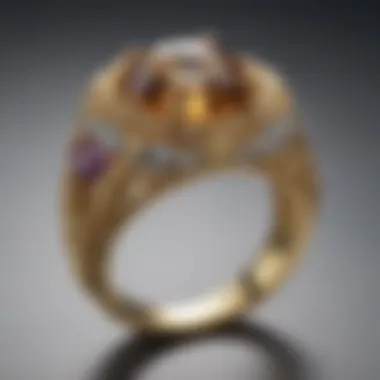
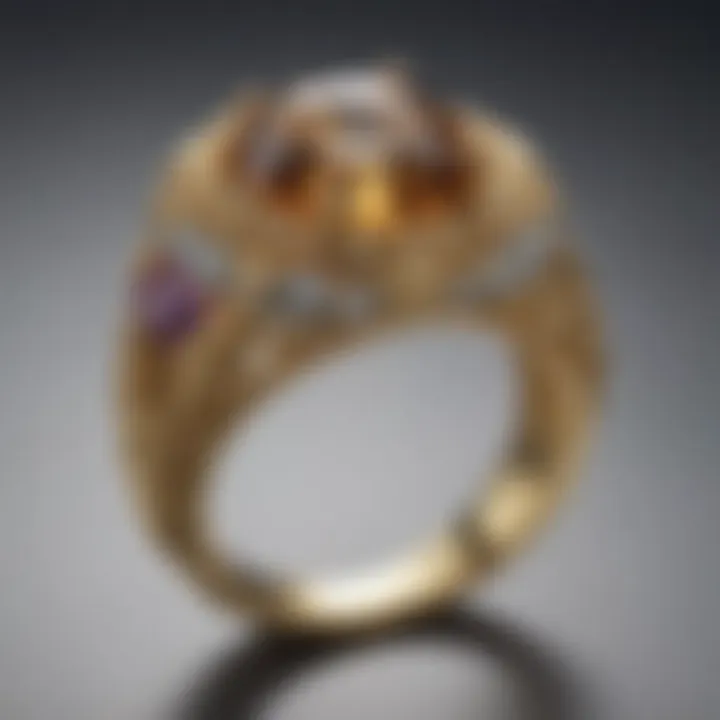
An ideal ring should slide on easily but shouldn't be so loose that it can turn with the slightest touch. Many jewelers offer resizing services, so if uncertain, consider opting for a slightly larger size. Here are a few tips:
- Sizing Tools: Utilize sizers available at jewelry stores.
- Printable Guides: Some jewelers provide downloadable guides to measure size accurately.
- Check More Than Once: Measure multiple times, preferably at different times of day or varying temperatures.
Budgeting for a Purchase
When engaging in the world of jewelry, budgeting stands as a critical factor that governs the choice. Gold rings come in a wide range of prices depending on factors like worksmanship, design complexity, and gold's market value. Setting a budget helps in narrowing down options without getting overwhelmed.
Begin by researching the average cost of 14 carat gold rings, consider what features matter to you, like the design and any gemstones involved. It's also wise to factor in some leeway for unanticipated costs such as resizing or polishing. Here are a few budgeting pointers:
- Research Prices: Familiarize yourself with the average market prices for similar pieces.
- Adjust for Design Elements: Evaluate if extra features, like engravings or specialized settings, fit your budget.
- Plan for Extras: Always consider maintenance costs such as cleaning and repairs post-purchase.
As you explore 14 carat gold rings, blending the artistic allure of these pieces with practicality allows for informed choices that resonate with both your heart and your wallet.
Care and Maintenance
Taking care of a 14 carat gold ring is not merely a chore; it’s an act of preserving a piece of art and emotion. Maintaining the sparkle and integrity of your ring ensures it withstands time, sharing its brilliance through generations. When we talk about care and maintenance, we delve into two primary facets: cleaning techniques and storage recommendations. Each element is essential in keeping your jewelry looking as good as new and extending its lifespan.
Cleaning Techniques
Cleaning a 14 carat gold ring should be handled with a mix of caution and thoroughness. Not only does regular cleaning keep your jewelry shining, but it also prevents the buildup of dirt or oils that can dull its appearance. Consider the following techniques:
- Gentle Soap and Water Method: Mix a few drops of mild dish soap with warm water. Soak the ring for about 15-20 minutes, then gently scrub it with a soft-bristle toothbrush. Rinse thoroughly and pat dry with a lint-free cloth.
- Jewelry Cleaning Solutions: There are commercial cleaners designed for gold jewelry. If you choose this route, ensure the product is safe for 14 carat gold. Follow the instructions on the label for best results.
- Avoid Harsh Chemicals: Steer clear of bleach or abrasive cleaners. They can cause irreversible damage to the finish of your ring.
"A little care goes a long way; a well-maintained ring speaks volumes about the owner’s appreciation of beauty."
Storage Recommendations
Proper storage is just as crucial as cleaning. How and where you store your 14 carat gold ring can prevent scratches, tarnishing, and tangled chains. Here are a few storage tips:
- Use a Jewelry Box: Invest in a quality jewelry box lined with soft fabric. This will protect your ring from dust and scratches.
- Separate Storage: If you own multiple rings or pieces of jewelry, store each item separately to avoid scratching. Consider using individual soft pouches or wrapping them in soft cloths.
- Avoid Humidity: Store your jewelry in a cool, dry place. Excess moisture can lead to tarnishing, even in 14 carat gold, which is less susceptible than higher karats but still vulnerable.
These practices might seem simple, but they underscore the commitment to longevity and visual allure of your 14 carat gold ring. Taking these steps ensures the ring’s beauty becomes a cherished memory, carried on for years to come.
Market Value and Trends
Understanding the market value and trends surrounding 14 carat gold rings is crucial for enthusiasts and potential buyers alike. The fluctuations in value can greatly affect both the jewelry's worth and its desirability. As the jewelry market constantly evolves, being informed helps in making sound decisions, whether for investment or personal enjoyment.
Factors Influencing Market Price
Several key factors can sway the market price of 14 carat gold rings. Here are a few important considerations:
- Gold Prices: The primary driver is the price of gold itself. Prices fluctuate based on global supply and demand, as well as economic conditions.
- Craftsmanship: The skill and artistry that go into designing and crafting a ring can add significant value. Rings made by renowned artisans often fetch higher prices.
- Brand Reputation: Well-established jewelry brands carry a certain prestige, which can elevate the ring's market value.
- Market Trends: Popular styles and changing consumer preferences can affect demand. For example, if there's a resurgence in vintage designs, rings fitting that description may increase in worth.
- Condition and Authenticity: The better the condition and the easier it is to prove authenticity, the more desirable the piece becomes.
"A ring’s value is not just about the gold; it’s about the story it tells and the craftsmanship that went into its creation."
Investment Potential
Considering 14 carat gold rings as an investment can be beguileing. Here are some points to ponder:
- Value Appreciation: Historically, gold has proven to be a solid investment. While it's not without volatility, many people look at gold as a hedge against inflation, making it an appealing choice for those wanting to see a return on their investment.
- Tangible Asset: Unlike stocks or bonds, a gold ring is a tangible asset that you can hold. This physical aspect is often reassuring in unstable economic times.
- Market Demand: The increasing interest in gold jewelry can potentially influence future prices. As more buyers enter the market, the value of existing rings can rise.
- Long-Term Worth: Investment in jewelry requires a long-term perspective. Trends can change, but genuine craftsmanship and quality materials tend to maintain value over time.
In sum, the market value and trends associated with 14 carat gold rings are not simply numbers and statistics. They reflect broader patterns in global economics, consumer preference, and the art of jewelry making, which collectively underscore the significance of these beloved pieces.
Ending
In this article, we've explored the multifaceted dimensions of 14 carat gold rings, delving into their material properties, rich history, aesthetic allure, and cultural resonance. Understanding these aspects is crucial for enthusiasts, collectors, and potential buyers alike. The importance of recognizing the lasting appeal of these rings lies not only in their intrinsic value but also in their emotional depth that connects buyers to significant moments in their lives.
The Lasting Appeal of Carat Gold Rings
14 carat gold rings hold a unique position in the world of jewelry for several reasons. Firstly, they strike a harmonious balance between purity and durability. With 58.3% gold content, they provide the warm glow of gold while maintaining a robust structure that withstands everyday wear and tear. This makes them an excellent choice for those who desire both beauty and functionality.
Moreover, the variety in alloys—like the intrepid yellow gold, the chic white gold, or the romantic rose gold—allows for personalization, catering to diverse tastes. Thus, there’s a 14 carat gold ring to suit every individual’s style, from the classic to the contemporary. Such versatility enhances their appeal, making them not just accessories, but statements of identity.
The cultural significance of these rings is equally remarkable. Often, they are chosen for milestones, such as engagements or anniversaries, symbolizing commitment and love. The stories carried within these rings—the laughter, the tears, the memories—transcend their physical form, creating a deeper connection.
"A ring isn't just a circle of metal; it's a reminder of moments that matter."
As such, investing in a 14 carat gold ring becomes a meaningful journey, not only tapping into the aesthetic attributes but also embracing the history and emotion that these exquisite pieces represent.



